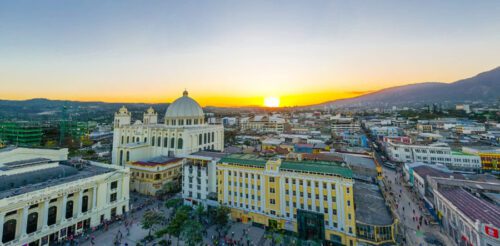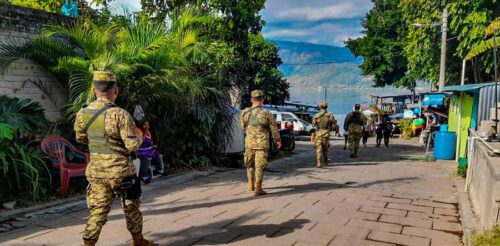The 18th Street gang, or Barrio 18, is a transnational criminal organization that began in Los Angeles in the 1960s, initially as a multi-ethnic street gang.
Known for its violent operations, it engages in drug trafficking, extortion, and murder. With a strong presence across the U.S. and Central America, Barrio 18 rivals MS-13 in brutality and influence.

About 18 Street or Barrio 18 Gang Profile
The 18th Street Gang, also known as Barrio 18, is one of the largest youth gangs in the Western Hemisphere, much like its better-known rival, the Mara Salvatrucha (MS13).
While the gang has cells operating from Central America to Canada, it has been greatly weakened in El Salvador following a nationwide security crackdown, launched by the Nayib Bukele government in March 2022.
Security forces have jailed over 10,000 alleged Barrio 18 members during the crackdown, which has continued into 2023. Those still at large have gone into hiding or fled the country.
But with thousands of members spread throughout Central America and the United States, the Barrio 18 remains a significant criminal threat in the region
History
The Barrio 18 first emerged as a small-time street gang in Los Angeles. While some accounts trace its origins to the late 1950s, the gang began to take its current form in the 1980s after splitting from the Clanton 14 gang.
It earned particular notoriety for its role in riots in Los Angeles that followed the acquittal of the police who brutally beat Rodney King, an African-American motorist.
Originally, the group’s many cells, known as “cliques,” were the exclusive province of Mexican immigrants in Southern California and dominated neighborhoods such as MacArthur Park in the Koreatown part of central Los Angeles.
However, as other Latino nationalities joined the immigrant population, the Barrio 18 began to recruit members from various backgrounds, a development that would facilitate the group’s spread into other nations, particularly in Central America.
In the late 1990s, a Federal Bureau of Investigation (FBI) task force and local law enforcement took down some of the Barrio 18’s foremost leaders. But this did not so much handicap the gang as give them another base from which to operate and recruit new members: federal prisons.
Despite efforts to isolate gang leaders from their contacts on the outside and their fellow prisoners, Barrio 18 bosses like Francisco Martinez, alias “Puppet,” devised ways to continue running criminal activities from the inside.
Some members of the Barrio 18 also joined the Mexican Mafia, a feared prison gang that grouped street gangs in Southern California into a single, powerful collective known as the Sureños. Outside of prison, the street gangs fight one another; inside, they form a single unit under the leadership of the Mafia.
SEE ALSO: Decoding Barrio 18 Tattoos: 18th Street Gang Symbols of Loyalty, Power, and Identity
The Barrio 18 spread south into Central America and Mexico mainly as a function of a change to US immigration policies in the mid-1990s, which increased the number of criminal charges for which any foreign-born resident could be deported to their country of origin.
The new policy was applied aggressively to gangs in California, where many gang members were not US citizens. The deportations led to a sudden influx of Barrio 18 and other gang members in Central America and Mexico, bringing with it violence and crime.
In the late 1990s, beginning in El Salvador, Central American governments started passing more stringent laws that criminalized mere “association” with gangs.
These so-called mano dura (iron fist) policies led to mass arrests of gang members that inadvertently spurred the gangs’ growth by concentrating their membership in prison, pushing them to reorganize and regroup.
On the outside, the Barrio 18 branched into petty drug trafficking and extortion. As profits grew, the gang also began laundering money through small businesses such as car washes.
Around 2005, infighting caused the Barrio 18 to split into two factions: the Revolutionaries and Sureños. These factions remain rivals, and have fought with each other with the same fervor as they do the MS13 —Central America’s largest street gang and the Barrio 18’s historic enemy.
The gang became most powerful in El Salvador, Guatemala, and Honduras, where it could exploit weak governments and high social exclusion to spread throughout poor urban neighborhoods.
In these spaces, the Barrio 18 began to systematically extort public transport systems, displace entire communities, and barge its way into politics.
This was most evident in March 2012, when Barrio 18 leaders and their MS13 rivals agreed to a nationwide “truce” mediated by a government envoy and the Catholic Church.
The country’s homicide rate plummeted by more than half following the ceasefire, but violence again exploded as the truce quickly unraveled.
The leaders of both the MS13 and Barrio 18 proved alarmingly adept at using their heightened, post-truce political profile to their advantage, fueling concerns that the initiative could provide a means of increasing their criminal sophistication and overall influence in the country.
To add to these concerns, extortion and disappearances reportedly continued to rise in El Salvador over the course of the truce, and homicides began rising again in mid-2013, reaching a peak in 2015, before dropping back again.
A radical drop-off in El Salvador’s murder rate starting in 2019 again thrust the country’s gangs into the spotlight.
Though state officials attributed the fall to its national security plan, there were multiple media reports of an informal pact between parts of the El Salvador government and imprisoned gang leaders, with the latter reportedly limiting killings in exchange for better prison conditions.
The period of relative peace in El Salvador was shattered when members of the Barrio 18 and MS13 racked up 46 murders during a three-day killing spree in November 2021.
This was followed up by the indiscriminate massacre of 92 people, including shoppers, traders, and bus passengers, in March 2022. The Barrio 18 quickly distanced itself from the massacre, seen as an apparent attempt to send a message to the government.
Incensed by the brazen violence, the government responded with the most extensive gang crackdown the country had ever seen, arresting tens of thousands of suspected gang members during a state of emergency enacted in March 2022 and which remains in force as of November 2023.
The crackdown has decimated the Barrio 18’s rank-and-file, sending thousands fleeing or into exile. For the first time in decades, the gang has lost control of key territories and criminal economies in areas it once ruled with an iron fist.
In November 2022, Honduran President Xiomara Castro tried to replicate Bukele’s crackdown by declaring a state of emergency to deal with rising extortion. But the measures have failed to make a dent in gang activity and the Barrio 18’s ranks remain intact in Honduras.
Leadership
At the top are palabreros (leaders), most of whom are in the prison system. They coordinate all criminal activities. One palabrero keeps a notebook that keeps track of all finances, homicides, drugs, and weapons.
In El Salvador, four of the highest-ranking leaders of the Sureños faction, including Carlos Lechuga Mojica, alias “El Viejo Lin” sent an audio recording to members on the outside requesting an end to the killings that shook the nation in November 2021. This led to speculation that there had been a rupture between the gang’s imprisoned leaders and its street leaders.
Although many of the higher-ranking members were already incarcerated by the beginning of the gang crackdown in March 2022, many of its street leaders were either imprisoned or forced to flee.
In Guatemala, a group known as the “Rueda” (wheel) coordinates the gang’s activities. Many of these members, including its leader Aldo Dupie Ochoa Mejía, alias “El Lobo,” are currently imprisoned. Likewise, the Barrio 18’s main leaders in Honduras, such as Nahum Medina, alias “Tacoma,” operate behind bars.
Outside, the gang organizes itself in canchas. A cancha is a territorial division that isn’t necessarily based on municipal delineations. Each cancha has several tribus, or tribes, the smallest units of the Barrio 18 organization.
Finally, there are collaborators: those who are not quite or never will be gang members. They help the gang with small jobs, like gathering intelligence and moving or holding illicit goods.
Geography
In Central America, the gang operates mostly in El Salvador, Guatemala, and Honduras. It had over 22,000 members in El Salvador alone as of mid-2023.
The gang also has a major presence in the United States, with an estimated 30,000 to 50,000 members during the 2010s. The group operates in dozens of cities across an estimated 20 states.
Many of its members are located in California, but the Barrio 18 also has a presence in other western cities like Denver. Barrio 18 has also had a presence in Italy since the mid-2000s, and in September 2016 the arrest of an alleged Barrio 18 leader hinted at the gang’s desire to expand their presence in Europe.
Police in Spain highlighted this danger when they arrested 15 Hondurans in 2023 who they said were seeking to set up a Barrio 18 clique in Barcelona.
There have also been reports that Barrio 18 members fleeing the crackdown in El Salvador have been moving into southern Mexico.
Allies and Enemies
The Barrio 18’s main rival is the MS13. The Barrio 18 in El Salvador is divided into rival factions, the Revolutionaries and the Sureños, a division which has routinely flared into violence.
The gang also has a close relationship with the Mexican Mafia. It is also known to have networks of lawyers, taxi drivers, and mechanics as collaborators. The gang has routinely clashed with state security forces during successive anti-gang crackdowns in Central America.
Prospects
The Barrio 18 is a shadow of its former self in El Salvador, with more than half of its members jailed during the 2022-2023 crackdown, according to police estimates. With its ranks depleted, the gang has surrendered strategic territories and can no longer operate criminal economies pivotal to its economic survival.
A swift comeback seems a remote possibility in El Salvador, but there have been minimal disruptions to the Barrio 18’s well-established presence in other countries, where the gang remains an important criminal force.




